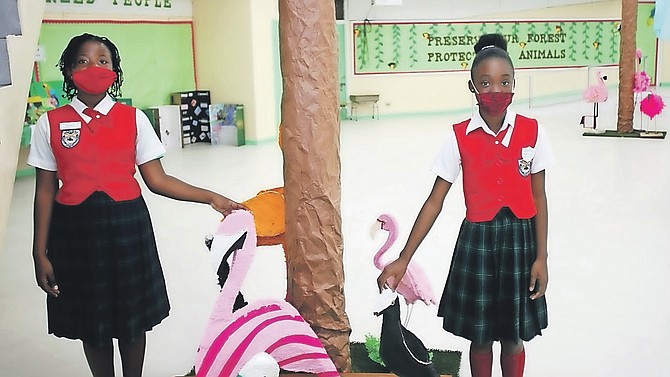DESTINY Wilson and Phillea Strachan are pictured with some of the animals created by students of Uriah McPhee Primary School. Photos: Patrick Hanna/BIS
PAPIER mache, picture books, cardboard televisions, brochures, posters and 3-D models are all ways in which students of Uriah McPhee Primary School depicted their assignments for a Science Literacy Exhibition.
The school recognised Science Week from March 28-31 with activities including Science Talk, a virtual field trip to Bahamas National Trust, and a rap/poem competition. The theme: “Preserve our Forests, Protect our Animals.”
Among the activities was an exhibition for which the students were required to:
• Create a pine forest and feature endangered land animals found in The Bahamas.
• Explain the significance of pine forests and endangered land animals of The Bahamas to the environment.
A view of the exhibition in the school’s newly renovated auditorium revealed: a replica of an erected pine forest, 3D models of flamingoes, trifold posters with endangered land animals, pop-up books, some showing pictures of crown pigeons, the Bahama parrot, iguanas and wild horses and so much more.
Science coordinator Shaphalle Knowles said: “Students were required to explain the significance of the pine forests to the eco-system which is important because it provides a home for so many of our endangered animals including the Bahama Parrot. Each grade level had a contribution to the exhibition.”
Grade 1 students created big and small picture books of the pine forests.
“Some of the students outdid themselves. They were so detailed in their efforts. It came out so lovely. They created pop-up books. Their focus was on the endangered land animals as well.
“All of this is to teach them about the pine forests and endangered animals. This is a part of our science curriculum. We [also] study the ecosystems, coral reefs, mangroves. We pull a theme from our science curriculum and go to town with it.
“They can learn how to conserve their environment for generations to come. If we don’t preserve our environment we won’t have anything left to enjoy.
“When you start with the children at an early age it creates a different mindset for them as they grow. The earlier you start the better off they are. They will understand automatically when they leave primary school into high school that conservation is the way.”
Of grade 2’s TVs, some flat screen, she said, “As you turn the roller on the cardboard TV you will see information about the pine forests and the endangered animals. There is plastic covering in front of the TV for the screens. The rollers are made with hand towel holders to show the different channels with information about the pine forests.”
There were also brochures, some handmade, showcasing endangered land animals created by students of grade and 3D models of flamingoes (4 feet) by grade 6.
Head girl Phillea Strachan said the bright, orange flamingo was that color because of what they eat. “It depends on what they eat they would change their color,” she said.
“Parrots - one of our indigenous animals - back in the day they killed them for meat. The White Crowned Pigeon they killed them for food.”
Destiny Wilson, prefect, added, “In the 1950s there were only about 6,000 left until The Bahamas put up laws to protect them. Now there are 70,000 or 80,000 of them left. They are now reproducing and having a healthy life on Little Inagua.
Wilson said she found the work exciting and learned why it’s important to take care of the endangered animals.
“This is real; science is every day. We want our children to be able to live it out, to experience what it’s like. All of the topics we choose for display are on the GLAT. So, it’s reinforcement,” said Pamela Armaly, Principal.






Comments
Use the comment form below to begin a discussion about this content.
Sign in to comment
Or login with:
OpenID